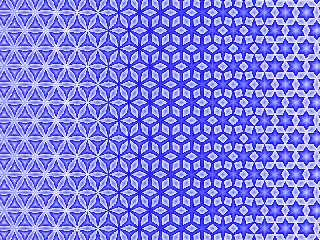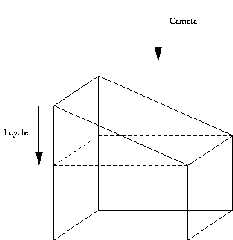 |
 |
|
 |
|
 |
|  |
|  |
|
 |
|
 |
|  |
|  |
|
 |
--
camera { location -4*z} #include "functions.inc" plane {z,0 pigment {
function {(1+x/4)*(1-f_hex_x(x*5,y*5,z,0))
+(2-x/2)*f_hex_y(x*5,y*5,z,0) -0.75 }
colour_map {[0 rgb z][1 rgb 1]} } finish {ambient 1}}
Post a reply to this message
Attachments:
Download 'Transition.jpg' (406 KB)
Preview of image 'Transition.jpg'

|
 |
|  |
|  |
|
 |
|
 |
|  |
|  |
|
 |
Mike Williams wrote:
> --
> camera { location -4*z} #include "functions.inc" plane {z,0 pigment {
> function {(1+x/4)*(1-f_hex_x(x*5,y*5,z,0))
> +(2-x/2)*f_hex_y(x*5,y*5,z,0) -0.75 }
> colour_map {[0 rgb z][1 rgb 1]} } finish {ambient 1}}
Excellent.
Reminds me of an article, either in SciAm's old Computer Recreations
column or in Martin Gardeners excellent Armchair Universe book, about
"parquat deformations" (spelling?) Escher being the archaetypal example.
It occurs to me (I don't really follow your math so this may already
be what you are doing, but if you have a texture that varies in say
y from one "parquat" to another and you take a diagonal slice from
say y = 1 on the left (x) to y = 0 on the right and an orthographic
camera looking in the -y direction you could do almost any transformation.
Figure attached - is this how your image works?
--
Bill Hails
http://thyme.homelinux.net/
Post a reply to this message
Attachments:
Download 'parquat.png' (4 KB)
Preview of image 'parquat.png'

|
 |
|  |
|  |
|
 |
|
 |
|  |
|  |
|
 |
parquet :-)
--
Bill Hails
http://thyme.homelinux.net/
Post a reply to this message
|
 |
|  |
|  |
|
 |
|
 |
|  |
|  |
|
 |
Mike Williams wrote:
> --
> camera { location -4*z} #include "functions.inc" plane {z,0 pigment {
> function {(1+x/4)*(1-f_hex_x(x*5,y*5,z,0))
> +(2-x/2)*f_hex_y(x*5,y*5,z,0) -0.75 }
> colour_map {[0 rgb z][1 rgb 1]} } finish {ambient 1}}
>
>
>
OK, that's just cool (no pun intended.) I was going to read a book
tonight, but now I guess I'll play around with the f_hex_x function
instead (at least to start with....then I'll probably poke over to your
tutorial site, 'cause there's something I forgot how to do, and probably
not get to bed until 2 a.m. -- you're so cruel. ;-) )
Dave Matthews
Post a reply to this message
|
 |
|  |
|  |
|
 |
|
 |
|  |
|  |
|
 |
Bill Hails wrote:
> Reminds me of an article, either in SciAm's old Computer Recreations
> column or in Martin Gardeners excellent Armchair Universe book, about
> "parqu[e]t deformations" Escher being the archaetypal example.
I think it was in "Metamagical Themas" (Hofstadter's anagram of
"Mathematical Games", after he took over the column from Gardner).
--
Anton Sherwood, http://www.ogre.nu/
Post a reply to this message
|
 |
|  |
|  |
|
 |
|
 |
|  |
|  |
|
 |
Wasn't it Anton Sherwood who wrote:
>Bill Hails wrote:
>> Reminds me of an article, either in SciAm's old Computer Recreations
>> column or in Martin Gardeners excellent Armchair Universe book, about
>> "parqu[e]t deformations" Escher being the archaetypal example.
>
>I think it was in "Metamagical Themas" (Hofstadter's anagram of
>"Mathematical Games", after he took over the column from Gardner).
Having now looked up some info on Hofstadter's parquet deformations, I
reckon that there's no connection with my technique.
--
Mike Williams
Gentleman of Leisure
Post a reply to this message
|
 |
|  |
|  |
|
 |
|
 |
|  |
|  |
|
 |
Very much in the spirit of Escher, indeed, Mike.
Well done. As always, you come up with mind (and eye!) stimulating examples.
Thomas
Post a reply to this message
|
 |
|  |
|  |
|
 |
|
 |
|  |
|  |
|
 |
Anton Sherwood wrote:
> Bill Hails wrote:
>> Reminds me of an article, either in SciAm's old Computer Recreations
>> column or in Martin Gardeners excellent Armchair Universe book, about
>> "parqu[e]t deformations" Escher being the archaetypal example.
>
> I think it was in "Metamagical Themas" (Hofstadter's anagram of
> "Mathematical Games", after he took over the column from Gardner).
>
Ah, right. My mistake.
--
Bill Hails
http://thyme.homelinux.net/
Post a reply to this message
|
 |
|  |
|  |
|
 |
|
 |
|  |
|  |
|
 |
"Mike Williams" <nos### [at] econym demon demon co co uk> wrote in message
news:426294a2@news.povray.org...
> --
> camera { location -4*z} #include "functions.inc" plane {z,0 pigment {
> function {(1+x/4)*(1-f_hex_x(x*5,y*5,z,0))
> +(2-x/2)*f_hex_y(x*5,y*5,z,0) -0.75 }
> colour_map {[0 rgb z][1 rgb 1]} } finish {ambient 1}}
Nice!!
Jim uk> wrote in message
news:426294a2@news.povray.org...
> --
> camera { location -4*z} #include "functions.inc" plane {z,0 pigment {
> function {(1+x/4)*(1-f_hex_x(x*5,y*5,z,0))
> +(2-x/2)*f_hex_y(x*5,y*5,z,0) -0.75 }
> colour_map {[0 rgb z][1 rgb 1]} } finish {ambient 1}}
Nice!!
Jim
Post a reply to this message
|
 |
|  |
|  |
|
 |
|
 |
|  |
|  |
|
 |
Mike Williams wrote:
Cool stuff.
-Shay
Post a reply to this message
|
 |
|  |
|  |
|
 |
|
 |
|  |




![]()